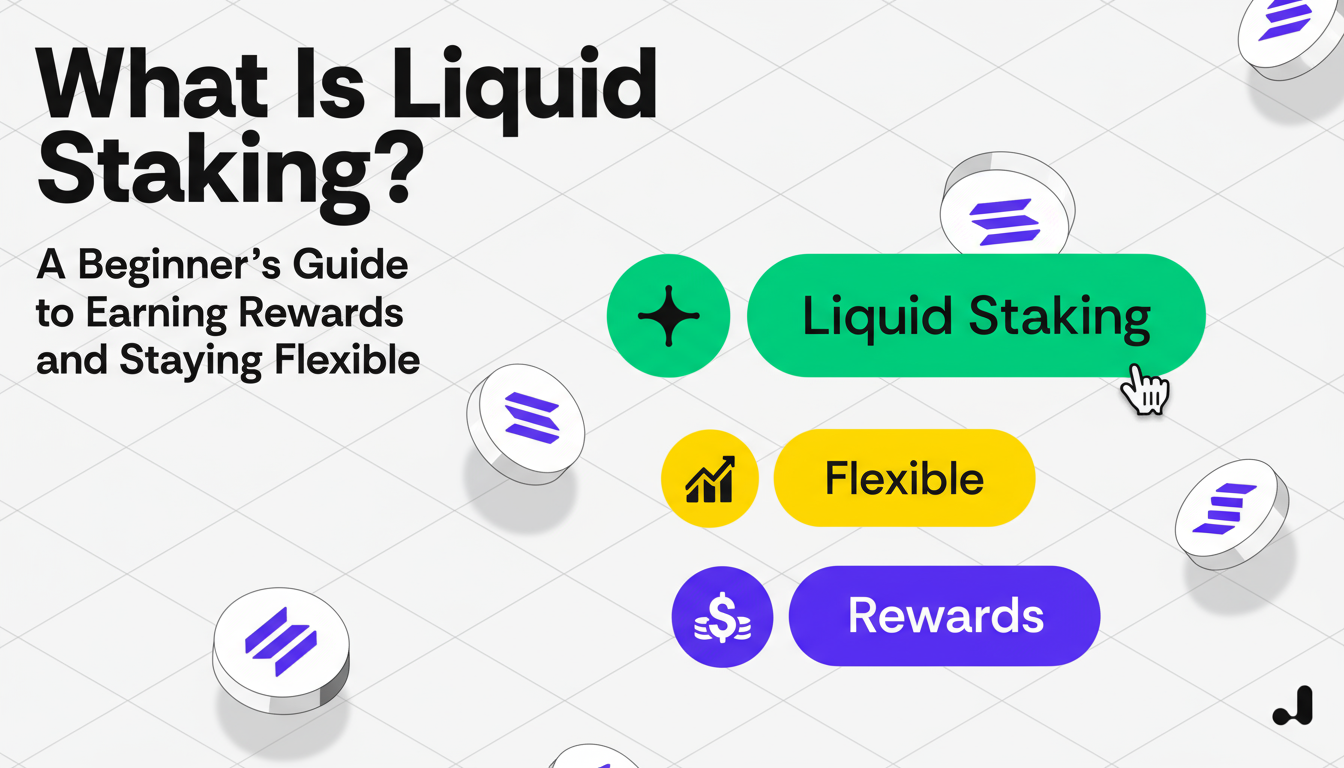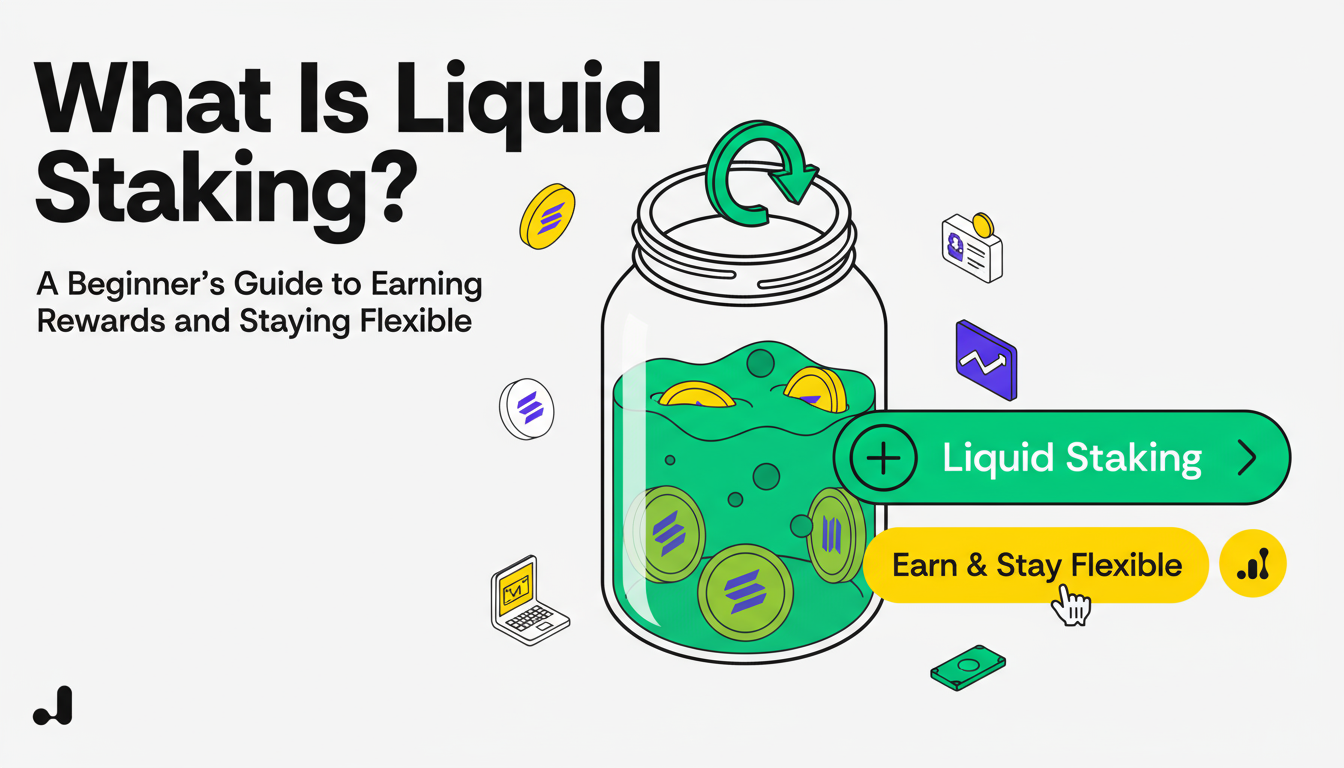What Is Liquid Staking? A Beginner’s Guide to Earning Rewards and Staying Flexible

The Limitations of Traditional Staking
If you’ve ever staked SOL, you know the feeling. You hit Stake, feel accomplished for a second — and then realize your funds are frozen. Days go by, sometimes longer. You can’t move or sell, even if the market turns around.
That’s the classic trade-off: earn staking rewards or keep your tokens liquid. For years, you had to pick one side. Not anymore.
This problem led to the rise of liquid staking, an alternative that lets you keep earning while your tokens stay usable.
What Is Liquid Staking in Crypto (and Why It Matters)
So, what is liquid staking? In simple terms, it’s staking without the handcuffs. You still delegate your SOL to validators, but instead of locking it away, you get another token in return — JSOL.
JSOL represents your staked SOL. Behind the scenes, it earns validator rewards just like before. The difference is, you can actually do something with it. Swap it, lend it, hold it, or use it in DeFi — all while your original SOL keeps generating yield.
In short, liquid staking turns staking from a waiting game into an active strategy. That’s why more people searching what is liquid staking crypto end up finding JPool — it’s the simplest way to combine yield and flexibility.
Why Solana Is Perfect for Liquid Staking
Let’s be honest: not every blockchain makes this idea practical. On networks with high gas fees, small moves can eat into profits. Solana’s different.
It’s fast, lightweight, and cheap. That means you can experiment with JSOL in DeFi without worrying about losing half your gains to fees. Swaps cost cents, sometimes less. And because Solana’s ecosystem keeps expanding — Raydium, Kamino, MarginFi, Orca, and more — JSOL isn’t just “proof” of staking. It’s an asset you can actually use.
That’s the real power of liquid staking on Solana: it isn’t theoretical. It’s live, integrated, and growing fast.
Why So Many Choose JPool
There are several liquid staking providers out there, but JPool consistently earns trust among Solana users. Here’s why:
-
Balanced validator network. JPool spreads your stake across reliable validators, supporting decentralization and reducing performance risk.
-
Transparency first. All validator stats, total value locked, and APYs are public — no guessing games.
-
Instant liquidity. You stake, confirm, and get JSOL in seconds. That’s it.
-
DeFi integrations everywhere. JSOL works with Solana’s top apps, meaning your staked tokens are never idle.
-
Community rewards. Through the Holders Club, users can earn JPoints, level up, and unlock perks.
It’s a mix of reliability, simplicity, and community — three things most staking platforms rarely combine.
The Key Advantages of Liquid Staking with JPool
Here’s what sets it apart once you start using it day-to-day:
-
You’re never locked. Your SOL keeps earning while staying available.
-
Your returns can stack. You get validator rewards plus whatever extra yield JSOL earns in DeFi.
-
You don’t waste time managing validators — JPool does it for you.
-
Transactions are smooth and low-cost, even if you’re testing multiple DeFi apps.
-
And honestly? It’s beginner-friendly. The interface is clear, and you see your results immediately.
All of that turns staking from a passive habit into a small, consistent source of motion in your portfolio.
How It Works (Real Example)
Here’s a quick story.
Alex and Dana both have 50 SOL.
Alex stakes directly with a validator. He earns around 7–8% a year but can’t touch the funds until the cooldown ends.
Dana stakes with JPool instead. She gets 50 JSOL instantly and earns the same validator rewards. Then she pairs part of it in a Raydium pool. Now she’s earning staking yield and liquidity rewards.
A year later, both earned from staking — but Dana’s SOL worked twice as hard.
The Risks: Real, But Manageable
No crypto product is risk-free. Here’s what’s worth knowing:
-
Smart contract bugs — every DeFi protocol faces this risk. JPool’s code is audited, but users should stay aware.
-
Price deviation — JSOL may temporarily trade a bit below SOL depending on market liquidity.
-
Validator uptime — JPool’s multi-validator setup limits issues, but performance still affects yields slightly.
Nothing dramatic, but it’s worth understanding before diving in. Transparency is part of what keeps the ecosystem healthy.
How to Stake SOL with JPool (Step-by-Step)
-
Set up a Solana wallet. Phantom, Backpack, or Solflare — any trusted one works.
-
Add SOL. Transfer or buy directly in the wallet.
-
Open app.jpool.one. Connect your wallet.
-
Enter amount. Choose how much to stake.
-
Confirm. You’ll see JSOL appear in seconds.
From there, it’s up to you. Hold JSOL, trade it, or use it in DeFi. You can even stake-and-forget, and still stay flexible if something new catches your eye.
To exit, swap JSOL for SOL on a DEX or use JPool’s native unstake option.
Inside the Holders Club
The JPool Holders Club adds a layer most staking platforms miss — fun. You earn JPoints for holding JSOL, doing community quests, or completing learning missions.
Those points push you up through tiers that unlock boosters, bonuses, and special campaigns. It turns staking from something passive into a kind of progression system.
It’s simple, but it keeps users connected — which is exactly what Web3 projects need more of.
Quick FAQ
Is liquid staking safe?
Safer than most DeFi experiments, but still not risk-free. JPool’s contracts are audited and public.
What happens if I sell JSOL?
Whoever buys it gets the staking rewards from that point onward. It’s how you exit instantly.
How much can I earn?
Validator rewards average 7–8% APY, plus whatever DeFi income you create with JSOL.
Can I choose validators myself?
No need. JPool’s algorithm balances them automatically for better decentralization.
Final Thoughts
For years, staking on Solana meant patience and limited control. You either locked your tokens or left them idle.
Liquid staking changed that.
With JPool, you stake SOL, receive JSOL instantly, and keep your options open. You earn rewards, join a growing ecosystem, and stay in full control of your funds. It’s staking that finally fits how crypto actually moves — fast and flexible.
If you’ve been wondering what is liquid staking crypto, this is where the answer turns practical.
Head to jpool.one, stake your SOL, and see it in action.
